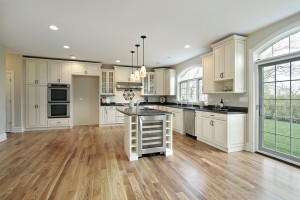A century ago kitchens were built with wooden floors or stone because that was the material available at the time. The introduction of ceramic tiles and vinyl flooring changed that situation as floors could now be made waterproof. Recent design trends have seen the reintroduction of wood, along with a few other materials, that are suitable for kitchens. Modern treatments have made these materials waterproof. Giving kitchen floors that are spill-resistant and lower maintenance than earlier designs.
This is an affordable and durable option. Not only does the multilayer wood offer additional strength in its construction, but it can be padded underneath to provide a comfortable surface for feet. Both of these factors are important if the kitchen is frequently used.
With a water-proof finish, the laminate wood is easy to clean under any normal circumstances.
A classic kitchen solution because it is affordable and offers the best of all options. It is easy to clean, highly water resistant, fairly long-lasting, and easy to replace. It is also available in many colours and designs, including imitation wood or stone. Best of all, it is quite soft underfoot.
Kitchen flooring was once a matter of practicality; the floor surface had be water-proof and non-slippery to prevent accidents. Now there is a much greater choice of flooring materials, so floors can be chosen for aesthetic appeal, with all the practical features included.

